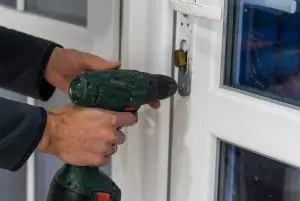Understanding the Legal Foundation of Fire Exit Hardware
Running a business means taking responsibility for everyone who walks through the door. That is to say, we must comply with fire exit hardware regulations not just because it’s smart, but because it’s the law. Across Canada, building codes and fire safety standards require clear and easy-to-use egress systems. Therefore, businesses must install proper exit devices that allow people to evacuate quickly without specialized knowledge or tools.
We always remind clients that these regulations are not optional. On the contrary, they are enforceable by law and subject to inspection by fire authorities. Furthermore, regulations typically require panic hardware or fire exit hardware on specific doors, especially those in high-occupancy areas. In other words, if you own or manage a commercial property, you must ensure compliance across every exit route. Non-compliance can result in liability issues, fines, or even shutdowns.
Where Fire Exit Hardware Is Legally Required
Not all doors in a building are treated equally under fire code. However, once you know which doors require compliant hardware, it becomes easier to stay ahead of issues. Most importantly, building exits serving large groups of people—like those in schools, hospitals, retail centers, or event spaces—must include panic hardware. That is to say, they need bars or devices that unlock the door with a single push motion.
In addition, exit routes used by employees in warehouses or office settings must meet very specific criteria. For example, many commercial doors must be self-latching and able to open without tight grasping or pinching. As a result, we often review doors leading from stairwells, corridors, and loading docks to ensure full compliance. Our team frequently handles these reviews as part of a full commercial locksmith Calgary service inspection.
We understand that not every business owner knows the code inside and out. Therefore, our job is to translate those legal requirements into practical changes that actually protect people.
Common Non-Compliance Issues Businesses Overlook
We often see fire exit devices installed improperly or modified over time. In some cases, that’s due to convenience. For instance, a door that should always remain unlatched may be blocked or tied closed. However, that’s a serious safety violation. On the other hand, sometimes exit bars are added to the wrong side of the door or mounted at the wrong height. These mistakes are easy to make but pose serious risks.
In our experience, businesses also fail to maintain hardware properly. That is to say, exit devices can fail if not tested, lubricated, or aligned regularly. Faulty springs, broken rods, or disconnected alarms are all problems we’ve addressed during routine inspections. As a result, we strongly recommend including fire exit doors in your quarterly maintenance schedule.
Additionally, we find that some doors are not connected to the fire alarm system as required. This is especially problematic when the doors are part of a larger access control setup. To clarify, fire exits must override any electronic locks or security settings in case of emergency.
Panic Bars, Alarms, and Exit Signage
The panic bar is just one piece of the fire exit puzzle. Equally important are the signs and alerts that guide people to safety. For instance, exit signs must be visible and illuminated even during power failures. Therefore, emergency backup power is required. Additionally, some exit doors must be alarmed to discourage unauthorized use while still allowing free egress.
We also emphasize the importance of choosing the right type of panic hardware. Some doors may require a crossbar, while others benefit from a vertical rod setup. That depends on door material, width, and the need for fire resistance. Likewise, when businesses use delayed egress systems for security purposes, the delay must be strictly timed and labeled.
As professionals in commercial lock installation services, we’ve helped many facilities select, install, and test these components. We focus on more than just the mechanical installation. Most importantly, we ensure that every piece of hardware works together as a life-saving system.
Coordinating Fire Exit Hardware with Security Needs
Security and safety often pull in different directions. That is to say, a secure facility may want to keep intruders out, while fire code demands that people be able to get out easily. Consequently, exit doors should never be blocked, double-keyed, or left bolted. This creates a challenge, especially for properties that face theft concerns or vandalism.
To resolve this, we work with businesses to install panic hardware that supports alarms and controlled access. For instance, delayed egress hardware sounds an alert and unlocks the door after 15 seconds. This satisfies both code requirements and internal security goals. Similarly, electronic locks with fail-safe features unlock when the fire alarm activates.
As professionals in fire exit and building code compliance, we approach each door from both the safety and security angle. That’s how we help our clients maintain protection without violating codes or endangering lives.
The Role of Regular Inspections and Documentation
No compliance plan is complete without regular checks and proper documentation. To clarify, building owners must be able to prove that all exits are operational and meet code. This includes recordkeeping for hardware inspections, testing schedules, and repair logs. Without these, you’re at risk during an audit or incident investigation.
Moreover, many insurance policies now require documentation of life safety systems. Therefore, fire exit hardware should not be viewed as a one-time install. It is an ongoing responsibility. Our team conducts walkthroughs that identify code risks before they become violations. We also assist with system upgrades and reports that can be shared with fire marshals or insurers.
It’s easy to assume that once a device is on the door, your job is done. However, we’ve seen how quickly a jammed bar or failed battery backup can compromise an entire building’s safety. Keeping up with inspections ensures everything functions when it matters most.
Staff Training and Emergency Planning
Even the best hardware fails if people don’t know how to use it. That is to say, employee training is essential. We advise clients to include fire exit procedures in onboarding and annual safety drills. For example, everyone should know which doors to use, how alarms function, and when to report maintenance issues.
In addition, signage should be multilingual if the workforce is diverse. After all, a fire emergency isn’t the time to guess which way to run. Clear, direct instructions save lives. Therefore, part of compliance means reducing confusion and panic through preparation.
We also recommend assigning a safety officer or fire marshal within the business. This person should be familiar with inspection records, hardware layout, and evacuation plans. That way, leadership is ready when inspectors show up or emergencies unfold.
Upgrades to Modern Fire Exit Hardware
Hardware technology continues to evolve. Likewise, so do fire codes. Many older buildings still use outdated exit devices that no longer meet safety standards. As a result, we often suggest replacing legacy hardware with modern, code-compliant options. This includes hardware that is both accessible and intuitive to use.
For instance, some buildings are upgrading to touch-free panic bars. These allow exit without physical contact, which is beneficial for hygiene and convenience. Others are integrating hardware with building automation systems. This way, fire exits automatically unlock and light up when alarms trigger.
When our team works on a fire safety upgrade, we also check surrounding infrastructure. That includes door frames, wiring, power supplies, and alarm connections. Our goal is to make sure your entire exit system works together without weak links or outdated components.
Coordinating with Fire Departments and Building Inspectors
We’ve worked with many Calgary business owners who were unsure about code specifics. That is to say, interpreting fire code alone can be confusing. Fortunately, you don’t need to do it alone. Fire inspectors and code enforcement officers are often willing to explain what’s required. They want compliance, not penalties.
In our experience, collaborating early leads to better outcomes. For example, we’ve joined walkthroughs with building managers and inspectors to review fire exit plans. This proactive approach prevents misunderstandings and costly retrofits. As professionals familiar with fire exit code enforcement standards, we speak the same language as regulators. Additionally, we assist with paperwork and diagrams when necessary. Whether you’re opening a new site or modifying an old one, it pays to work with someone who understands both hardware and legal compliance. So give us a call.
The Real-World Consequences of Ignoring Exit Requirements
It’s easy to treat fire exit compliance as just another checkbox. However, history has shown us the real dangers of ignoring it. Tragic fires in nightclubs, factories, and offices have led to countless injuries and deaths because exit doors were locked, blocked, or non-functional.
More than that, businesses suffer major consequences after the fact. These include lawsuits, insurance denial, reputational damage, and even criminal charges. We’ve worked with clients after minor violations and major scares. Therefore, we always advocate for prevention.
The right hardware won’t just meet code. Above all, it gives your team and customers peace of mind during emergencies. You can’t predict when disaster will strike, but you can be ready to act when it does.
FAQ
What is fire exit hardware, and why is it required?
Fire exit hardware refers to devices like panic bars, push pads, and latches that allow fast, unimpeded egress from a building during an emergency. It is required by law to ensure public safety during fires or other evacuations.
How can I tell if my business is compliant?
The best way is to have a licensed locksmith or safety professional inspect your exits. They can assess whether your hardware meets building codes, is properly installed, and functions as intended during emergencies.
Can fire exit doors also be used for security?
Yes, but only with the right hardware. You can use alarmed panic bars or delayed egress devices that allow safe exit while deterring unauthorized use. However, these must meet specific timing and signage requirements under fire code.
Do I need illuminated signs over fire exits?
Absolutely. Illuminated exit signs are required by code and must function even during power outages. This ensures people can find their way out quickly in smoke or darkness.
How often should exit hardware be tested?
At minimum, quarterly inspections are recommended. High-traffic businesses may benefit from monthly checks. Always keep records of your inspections and repairs in case of fire marshal reviews or audits.





